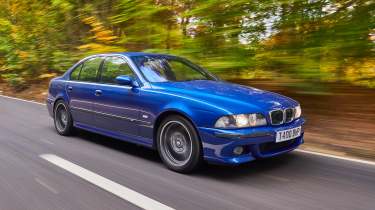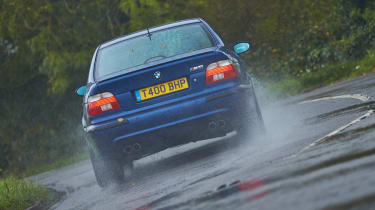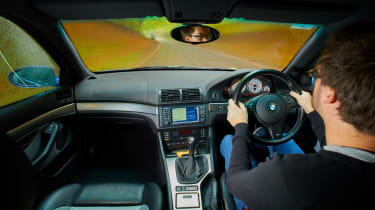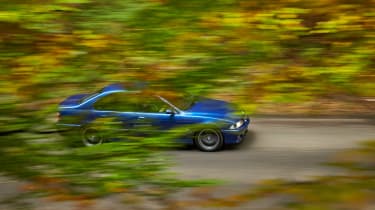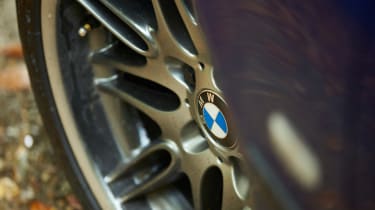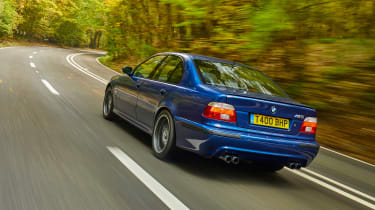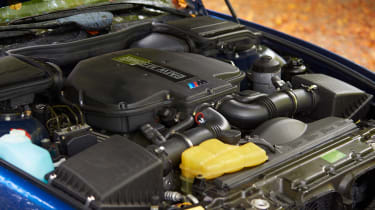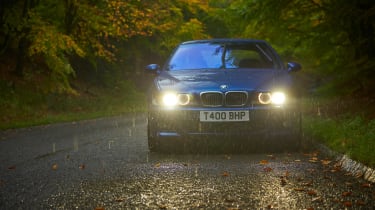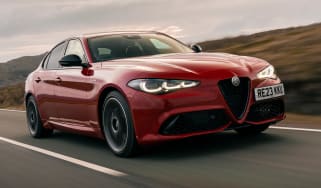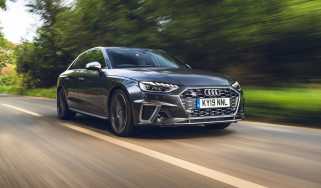BMW M5 (E39, 1998 - 2003): review, history and buying guide
When the E39 M5 arrived 26 years ago its 394bhp redefined the supersaloon. But as it was to prove, greatness isn’t about power alone
Today’s super saloons tend to favour fiendish speed and complexity over analogue thrills, but not the E39 M5. BMW’s third edition of the mighty M5 is dripping with understated menace, and from its gutsy 4.9-litre V8 to its intuitive rear-drive balance, it’s as honest as they come. In fact, with its naturally aspirated engine and manual gearbox, it’s one of the last traditional super saloons.
The E39 arrived in 1998 as a significant, and somewhat controversial, evolution of the formula established by the E28 and E34 M5. Gone was the trademark straight six that had featured in all BMW M cars since the M1, in its place an all-aluminium S62 V8 delivering 394bhp and 369lb ft to the rear wheels. Hyper hatch numbers today, but supercar numbers back then. More importantly though, is that the big-chested delivery and distant baritone rumble invite you to extend it at every opportunity, and its potency feels perfectly matched with the car's responses (and yes, the rear end’s propensity to smear across the tarmac). With its long wheelbase and linear torque delivery, it’s a textbook oversteer machine.
> BMW M5 Touring (E61, 2007 - 2010): review, specs and buying guide
But the best M5s, and by extension the best super saloons, can dial back the lairiness and contort to the driver’s demands at will, and the E39 is no exception. That it does so without a plethora of driving modes is perhaps its greatest trick – slot into sixth and the motor retreats, and the M5 finds impressive absorption over broken tarmac. The recirculating ball steering system – necessitated by the tight packaging of the V8 – is one of few dynamic weak points, lacking in any meaningful communication but proving surprisingly accurate at a flowing pace.
The E39 was itself a fairly significant update of BMW’s tried and tested M5 formula, forged with 1984’s E28 and continued with great success in 1988 with the arrival of the E34. For the E39 the application of ideas was the same – a muscular athlete in a finely tailored suit – but six in-line cylinders made way for an all-new, all-aluminium V8, branded S62. It was M’s first V8, and BMW’s first to use Double VANOS, which altered the timing of both intake and exhaust camshafts, and like its six-pot predecessors it used a throttle body for each cylinder to precisely meter fuel and air. The march of technology and another 1.1 litres of swept capacity allowed the S62 to deliver a 59 horsepower boost over the outgoing 3.8-litre E34, taking the total to 394bhp.
At nearly five litres, however, the main benefit was torque. Peak power came 300rpm sooner than with the ‘six’, but the V8’s 369lb ft was a considerable increase, and it came in nearly 1000rpm earlier than the E34’s 295lb ft. The engine would fight an overall kerb weight gain of 70kg but still deliver a 0-62mph time of 5.3sec, half a second ahead of its predecessor.
In many respects though, the E39 was evolutionary, from its under-the-radar styling inside and out, to its use of a six-speed manual transmission and mechanical limited-slip differential. Like the E34, it used MacPherson struts up front, now with lighter aluminium control arms, but at the rear was a multi-link set-up, replacing the traditional BMW trailing arm arrangement and giving the E39 a fighting chance of controlling its extra power and torque. Steering, however, was via a recirculating ball arrangement, BMW unable to squeeze a rack and pinion around the bulky V8.
I was 13 when the E39 M5 arrived, vaguely aware of the decade-old E34 M5’s existence but ignorant of its cultural impact within the car industry. Nevertheless, the E39 had me hooked from the start. One magazine’s opening spread was an over-the-shoulder image shot through the driver’s window, ground rushing below and the orange speedo and tacho needles pointing to improbably high numbers on the grey gauge faces. The car on the pages that followed was handsome and imbued with considered aggression, yet apparently capable of mixing comfort and performance in a way few contemporary rivals could muster. I was already sold on the idea of lightweight Caterhams and Elises and devoured everything I could on French hot hatches, but it was the M5 that added the concept of a supersaloon to my automotive lexicon.
And today, I’m finally getting to try one. Hidden between modern cars in a gloomy multi-storey, I almost walk straight past it at first, but subtlety has long been an M5 strong suit. The purpose is certainly there, with slim-spoked 18-inch wheels squeezed under each arch, and a staggered set-up that runs 245-section tyres up front and meaty 275s behind. Back in the day only those wheels and a set of quad tailpipes clearly separated it from the legions of M-kitted 528is that wore near-identical body styling.
There’s not much to take in once inside, but that’s not to denigrate one of the most logical cabins ever designed. The ostrich-like leather seat faces are an interesting touch, and only the Germans could use light grey to ‘liven up’ an otherwise gloomy colour palette – it does at least match those gauges – but few cabins seem so instantly familiar. The inner workings of electric adjustment and heating perhaps push the seat a little too high, but not enough to ruin an otherwise fine driving position. It’s hard to make a comparison with its modern equivalent without sounding like I’ve swapped my spectacles for a pair with a rosier tint, but the E39’s cabin does make you wonder where progress has been made.
The E39 was only slightly larger than the E34 – by an inch or two in all directions – but it is dwarfed by the latest car. Today’s F90 M5 is 182mm longer, 102mm wider and 61mm taller, and despite being one of the lighter supersaloons, a 1855kg kerb weight gives it 60kg of extra mass to haul about. And yet the E39 seems no less spacious – a function of slimmer pillars and less dashboard architecture – and it’d be no harder to house a pair of stereotypical executives in the back seats than it would in today’s M5.
It’s no less studiously constructed either. This car, from BMW UK’s heritage fleet, feels as fresh as you’d expect with only 20,000-or-so miles on the clock, but everything from the damped click of the indicator stalks to the oily action of the legions of dashboard buttons is as smart as in its 2019 equivalent.
There is, amusingly, satellite navigation, so it’s not devoid of screens. But you do get three pedals, a gearlever (with an illuminated legend) and a proper handbrake, all of which seem alien today. A simple and attractive three-spoke steering wheel too, whose rim is just the right thickness, rather than feeling like it could be used as a flotation device by a small child.
Twist the key and the car rocks as eight cylinders cascade into life. It’s the first sign and a rare glimpse of what lies beneath its steely exterior, like the CEO of a multinational playfully nudging a filing cabinet shut with their hips. Then the V8 just hums, becoming a rumble as the slightly rubbery shifter is gently persuaded into first and we pull away, then morphing into a distant growl as we join the flow of traffic. All that separates these distinct but muted stages are the smallest of throttle movements. Mooching around, the 4.9-litre responds like something with a tenth of its capacity, but it does so proportionally to your right foot, rather than jumping forward on some all-or-nothing throttle map.
The softly spoken approach to the styling and exhaust note helps lower the pulse in the ebb and flow of rush hour. There are a few lingering glances, but to the casual observer it’s just another old BMW swishing along another damp motorway on another dreary Thursday. Most of the other traffic appears to be one- or two-year-old 520ds.
I’m sticking to the inside lane anyway, at least until the rev counter’s characteristic orange LEDs have slowly extinguished as the V8 comes up to temperature. Half of the dial’s 8000rpm sweep is off-limits when cold. If you have any mechanical sympathy you’ll wait anyway, but no manufacturer since has come up with a more intuitive indicator as to when it’s safe to open the taps. Apart from Hyundai, that is, whose i30 N features an identical system. It’s almost as if there are a few ex-BMW engineers working there now…
As each light disappears I venture further into the throttle pedal’s travel. There’s quite some way to venture: the floor-hinged pedal scribes a long arc into the footwell, and as at low speeds, flexing your foot reveals proportionally greater depth to the car’s performance.
The gearing is tall, but there’s measurable acceleration even from low revs in top gear. Or fifth. Or fourth if you really need to sprint past traffic. The swelling power is all the more satisfying considering the momentary hesitancy and flustered two- or three-gear downchanges when you call for acceleration in a more recent supersaloon. In many ways it makes the E39 M5 less mentally taxing than subsequent iterations. With a manual ’box and natural aspiration, you know exactly how much acceleration you can expect from a certain gear, with a particular amount of throttle and at a defined point in the rev range, rather than working with the whims of fickle electronics.
It comes as no surprise that the M5 feels great at speed, I suppose, but I wasn’t expecting it to feel quite so pliant either. The tyres are low profile even by today’s standards – 40 up front, 35 astern – but there’s give in the springs and dampers that makes light work of the busy surface textures and random lumps that pervade British roads.
The sky is darker now and the automatic wipers have, over the last few miles, begun to spring into life. Within minutes it’s really coming down, but chattering raindrops aside, the M5’s cabin remains serene. Tyre and wind roar are distant, and if the engine has deep reserves of energy from the smallest throttle openings, it also speaks with a gentle voice at 70mph or so. It helps that the V8 is so smooth. Since that first wiggle on its axis when it sprung into life, it’s been a model citizen, changing in volume and eagerness but not sending so much as a fizz through the pedals or gearlever.
Venturing further into the wilderness in search of more challenges, the M5 is still dealing with poor surfaces, but while the ride is filtering out the wrong messages, the steering seems to be filtering out everything. evo’s John Barker commented on the muted steering when he drove the E39 at its launch 21 years ago. It’s because of the aforementioned packaging issues, but so perfect has everything else been until this point the numbness at my fingertips makes me wince. That’s not to say it’s short on response. In fact, the M5 carves through the exit slip road with precision and attitude. It rolls too, but does so at the same rate you’re inclined to feed in steering lock. In the few split seconds it takes to settle, the chassis takes on that intuitive rear-drive stance of feeling like it’s pivoting around the driver’s seat, ready to adjust its line predictably to any change in throttle or steering.
More involving roads with tighter turns mean more opportunities to extend the engine. What felt good in fifth or sixth feels wonderful in second and third, with a boundless energy from low revs that extends right through to the 7000rpm red line. With nigh-on 400 horses to play with and a kerb weight around the 1.8 ton mark, the car it immediately brings to mind is the current Ford Mustang, but the BMW is less rowdy, more cultured and more responsive.
Despite water now streaming from the sky and running at inopportune angles across the roads, the M5 doesn’t lean too heavily on its electronics, at least in a straight line. When the little orange light does blink, it’s as the engine is making its final lunge to the red line, from 5000rpm or so. Above 4000 the sound has already taken on a harder edge – it’s probably just as well the warm-up lights start here, as it’d be hard to resist if you accidentally strayed past it – and the V8 howls with mellifluous urgency to signal that it’s time for the next gear.
As the road gets more demanding, so the opportunity arises to explore the M5’s abilities. The stability systems will remain on today – BMW has asked us to be gentle with its near-pristine example, and there’s other traffic about – but with each mile the M5 reveals a little more about itself. The first discovery is that feedback does eventually materialise, once the tyres begin to smudge across the road surface and force greater loads through the steering box. It’d surely be better still on dry roads, but the car is finding good grip even in the wet. With so much throttle travel it’s also easy to accurately feed in the desired amount of power before the dashboard light starts blinking again.
To put the E39 M5 into context we need to look back to eCoty 1999. Yes, the Porsche won, but in fourth place (out of 12) finished the M5. Beaten by the 360 Modena and Impreza RB5, but ahead of the mighty R34 GT-R. The supersaloon has got bigger, faster and more advanced, and become more complete, but I’m not convinced it’s got any better.
Buying checkpoints
Unfortunately, while the E39’s age gives it irresistible charm, it’s also a source of potential trouble. The motor's VANOS system, which uses oil pressure to tweak cam timing for the intake and exhaust valves, is a well-documented weakness. The helical gears that adjust the camshafts can wear, characterised by a rattle at low revs. Another common VANOS gremlin is an oil seal failure, which causes the system to lose pressure and become jammed at a certain degree of advance or retardation. Depending on the extent of the required repairs, expect a bill of around £600 to restore full functionality.
Other engine niggles include faulty mass air flow sensors (MAFs), which can sometimes go unnoticed with no apparent loss of power, but drivability and response will suffer with poor sensors. Thankfully, the S62 uses a timing chain rather than a belt, but the tensioner can wear out on higher mileage examples.
The rest of the drivetrain is robust, but as can be the case with BMWs of this vintage, decades of all-weather use allows rust to take hold. Check the sills, jacking points, inside the fuel filler cap and the bottom of the doors for rot – generally speaking, you're better off spending a little more for a rust-free car since problems on the surface can quickly amount to serious (and expensive) remedial work. Solid examples with around 60,000 miles on the clock sit in the mid-£20,000 bracket, with exceptional cars commanding upwards of £30,000. As the E39 reaches icon status, values are climbing and show no signs of slowing down. Drive one and you'll find out why.
BMW M5 (E39) specs
| Engine | V8, 4941cc |
| Power | 394bhp @ 6600rpm |
| Torque | 369lb ft @ 3800rpm |
| Weight | 1795kg |
| Power-to-weight | 223bhp/ton |
| 0-62mph | 5.3sec |
| Top speed | 155mph (limited) |
| Price new | £52,000 (2002) |
| Value today | £25,000-40,000 |
